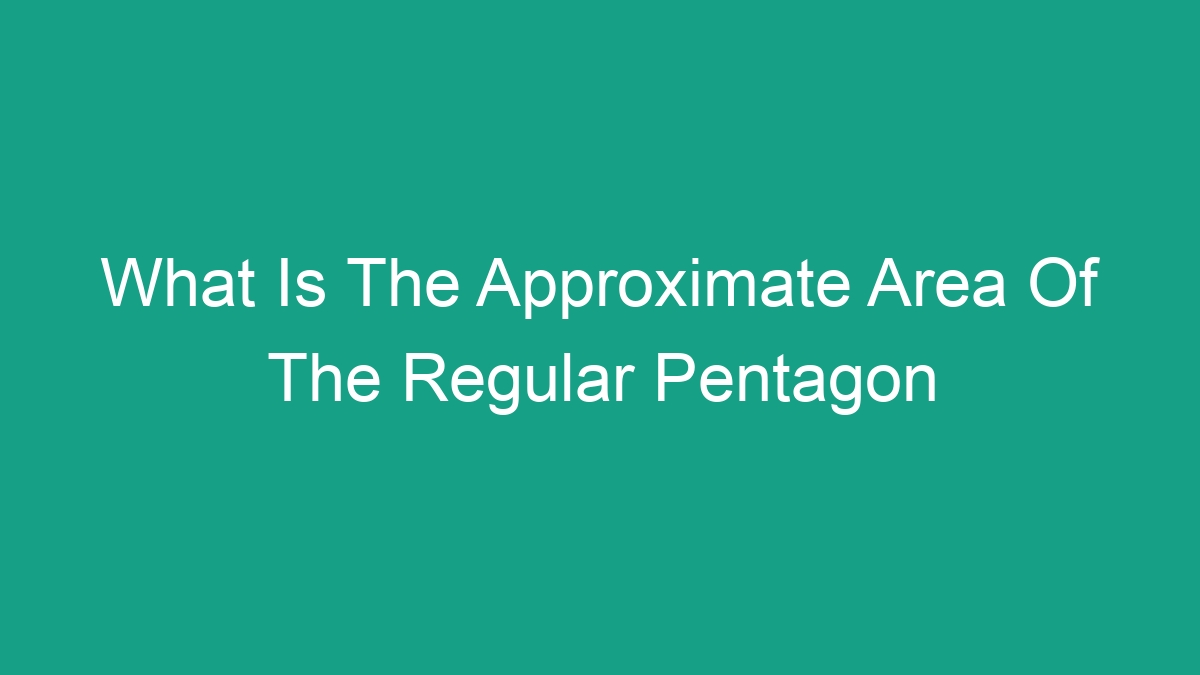
A regular pentagon is a five-sided polygon where all sides and angles are equal. Determining the area of a regular pentagon can be a bit complicated, but with the right formula and understanding of the shape, you can easily calculate it. In this article, we will discuss the approximate area of a regular pentagon, how to calculate it, and provide some examples for better understanding.
Understanding the Regular Pentagon
Before diving into the calculation of the area, let’s take a moment to understand the characteristics of a regular pentagon. A regular pentagon has the following properties:
- All sides are of equal length
- All interior angles are of equal measure
- The sum of interior angles is 540 degrees
- The shape has five lines of symmetry
These properties are important to keep in mind when determining the area of a regular pentagon.
Formula for Calculating Area
The area of a regular pentagon can be calculated using the following formula:
Area = (1/4) * (5 * (s^2)) * (1/tan(π/5))
Where:
- s is the length of one side of the pentagon
- π is the mathematical constant pi (approximately 3.14159)
- tan is the tangent function
This formula takes into account the side length of the regular pentagon and a trigonometric function to calculate the area. It may seem complex at first, but once you understand the components, it becomes a straightforward process.
Calculating the Approximate Area
Let’s use an example to illustrate how to calculate the approximate area of a regular pentagon. Suppose we have a regular pentagon with a side length of 10 units. We can plug this value into the formula to find the area.
Area = (1/4) * (5 * (10^2)) * (1/tan(π/5))
After calculating this using a calculator or a programming tool, we find that the approximate area of the regular pentagon is 172.05 square units.
Real-Life Application
The concept of a regular pentagon and its area calculation might seem theoretical, but it has practical applications as well. For instance, in architecture, regular pentagonal shapes can be incorporated into the design of certain buildings or structures. Knowing how to calculate the area of such shapes is essential for accurate measurements and planning.
Furthermore, in fields such as engineering and construction, the understanding of geometric shapes, including regular pentagons, is crucial for various calculations and designs.
Challenges in Area Calculation
While the formula mentioned earlier provides a way to calculate the area of a regular pentagon, it’s important to note that this process can be challenging for individuals who are not familiar with trigonometric functions. Additionally, the formula itself might seem intimidating for those who have not encountered it before.
However, with the availability of online calculators and digital tools, it has become easier to perform such calculations accurately. It’s also a good opportunity for individuals to learn and understand the underlying mathematical concepts.
FAQs
Q: Can the area of a regular pentagon be calculated using a different formula?
A: Yes, there are alternative formulas for calculating the area of a regular pentagon, but the one mentioned in this article is widely used and considered to be accurate.
Q: Is the area of a regular pentagon different from an irregular pentagon?
A: Yes, the area calculation for a regular pentagon is specific to its properties of equal sides and angles. An irregular pentagon would require a different approach for area calculation.
Q: How can I visualize the area of a regular pentagon?
A: To visualize the area of a regular pentagon, consider drawing the shape on graph paper or using a geometry software. You can then calculate the area using the formula and see how it fits within the boundaries of the shape.
Q: Are there practical uses for knowing the area of a regular pentagon?
A: Yes, as mentioned earlier, fields such as architecture, engineering, and construction often involve the use of geometric shapes in designs and measurements. Understanding the area of a regular pentagon is valuable in such applications.
Q: Are there any real-world examples of regular pentagonal structures?
A: The Pentagon in Washington D.C. is a famous example of a regular pentagonal structure. It is a well-known symbol of the U.S. Department of Defense and serves as the headquarters for the nation’s military forces.
Conclusion
Understanding the approximate area of a regular pentagon is essential for various applications in mathematics, engineering, and architecture. With the right formula and knowledge of the shape’s properties, individuals can easily determine the area of a regular pentagon. While the calculation may seem daunting at first, practice and familiarity with the formula can lead to accurate results.




